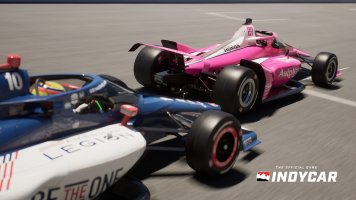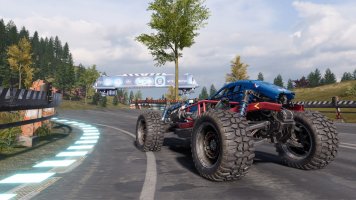You can learn some more aero info by looking at telemetry.
Actually, yes one can understand the effects aero drag and downforce have on chassis and suspensions. That is not what I'm referring to - there is not enough control over body/wing/undercarriage surfaces to directly understand/feel the relation between aero setup changes and car behaviour.
More over, there is no information on what type of aero mapping is done, what equations are being used. Couple that with what I say above and aeros are still an area of uncertainty.
When was the ISR piece filmed? The 'new aero model' I remember was actually released close to 2 years ago.
The piece, if I'm not mistaken, is not 2 years old, therefore the "new aero model" hadn't either been released or had undergone "surgery".
Right, but with the empirical models we still see some models getting great reviews (AC) and others being panned (pCARS). The methodology for filling in the blanks is theory unto itself, and as developers get better at it we get better modeled behavior.
Wow.
AC, as far as I know, is not even semi-empirical in nature. They have adopted a physically based modelling, last I read/heard. Even NKP was already transitioning to a more physically oriented model.
As for C.A.R.S., AJ's model is not semi-empirical, let alone empirical. Its foundations are physical, reason why I believe it will take time to...er..."get there". The methodologies he explained for his SM are rather clear on what type of approach he had to drop and which he chose to follow from the ground up.
It's those things the tire manufacturers don't test for (camber, curbing, high slip, etc) that make or break a sim.
No. Again, I know of test programs executed by tire engineers in close cooperation with racing teams. The range of "things" they test for are far wider than the usual typical passenger car road test (or rig test). Moreover, some of the test rigs I have seen are far more sophisticated than those tire engineering literature seem to focus on.
There are 2 or 3 conditions which, even with the most sophisticated and robust test setups (fixed, rig based, or mounted on trailers or vehicles), are still difficult to test:
- extreme cold
- extreme humidity
- dirt/irregular surfaces
But, as I said, these tests are quite costly and are usually done for a specific purpose. They are doable, but require close cooperation between different teams, significant resources and money.
Just because race teams and manufacturers use the data effectively doesn't make it suitable for a sim.
No, on the contrary. The data is, shall we say, far reaching in that unusual conditions are simulated/performed (very high pressures, very low pressures, at reasonably high speeds, at different levels of degradation and wear, different temperatures, from shallow camber angles to unusual camber angles, very high loads for an individual tire).
The difficulty these teams have lies in extracting the data efficiently (with as little loss and deviation as possible). Contrary to typical tests (where extreme conditions are scrapped off as...noise by Michelin/Goodyear/etc), these tests give reasonably comprehensive pictures of what is happening.
That is not to say that everything there is to know is...knowable. No.
You're right that it's a known data set, but the fact no in development sims use Pacejka models anymore should tell us something
No, it only means that depending on manufacturers (cars, tires, etc) is perhaps proving to be more troublesome now than in the past.
Again, I refer you back to this simple analysis:
- from data (and I'm not saying typical, downsized data obtained from some 10 year old road car test; no, I refer to more complete tests), you derive behaviour. All you have to do is find the algorithms (math wise but also code wise) to achieve that behaviour. Not easy, but feasible and reasonably accurate.
- or you come up with a set of assumptions on tire construction and compounds and from there try to derive behaviour.
No approach is flawless, no. But one has proven itself. The other not.
I know, you will again say that tire tests don't look for extreme conditions, and I will again say that I have seen data from very costly and complete tests. In the end, the reasoning behind the transition you alluded to previously is this: we have to transition because tire data is incomplete; it's not the method/model that is wrong, but rather the data it's being fed on, but lets blame it on the model instead. Well, why not spend a little more money on what really matters (finding the proper data, funding proper, comprehensive tests) instead of millions invested on assumptions that may be proven wrong? Easy, novelty sells and looks the part (i.e., hey, it solves old problems, a saviour).
. Making sure that your model matches the SHAPES of the Pacejka curves is still worthwhile, but nobody just uses the Pacejka coefficients for modern sims anymore, not even adding carcass movements and other effects on top (at least, not that I'm aware of).
Just because development studios are following that trend it doesn't mean it is the right one.
Tire/Race engineers laugh a bit at the claims being put in the open about simracing's "physical tire modelling". They do praise the ingenuity of it, but results wise or believability? Nah.
I read that many times, I know CalSpan was somewhat involved. But that says nothing about what I asked. [You yourself can go to CalSpan and ask them (or any other testing facility) to perform a zillion tests.] But do you know anything about the validity of the tests performed for iRacing? No.
Ideally in the future they should (dangerous word) be able to grab the actual rubber/carcass formulas from the manufacturers, plug the data in, and have full tires, rather than grabbing the manufacturer's Pacejka data and extrapolating for the edge cases.
Well, it doesn't work that way. The way some people are acting is similar to a group of fans of a certain renown physicist - they claimed he was close to a Theory of Everything. Here, it's DK's Theory of Everything for the Tire, just plug in compound/carcass formulas (chemical formulas, materials stress formulas, etc, etc, etc) and voilá a real tire is made on 1s and 0s.
It doesn't work like that. You and I know better than that.
I've thought for a while that they really need a tire manufacturer partnership to fully realize the model, or at the very least to hire a proper tire engineer so DK doesn't have to do the tire constructions as well as the background math. Someone who knows how to build a proper race tire with practical knowledge, rather than DK who's doing all his learning through books. Remember, I think the tires feel like poorly designed tires

Yes, and you thought correctly. If someone intends to replicate a physical tire, one must build one from the ground up - in real life. But then, as I said above, no two tires are identical, so you'll still have to contend with the fact that you are only building ONE unique tire with a certain carcass and construction, with a certain ratio of compounds, you cannot extrapolate to tires that are rather different from that one.
That is the big fallacy of physical tire modelling as some profess it to be.
IT DOESN'T WORK LIKE THAT.
The stated goal was to be able to build tires without complete tire tests being done on them. If the manufacturer doesn't have the data or doesn't want to part with it, for example. And, of course, it's a bit more methodical for making your predictions of unknown behavior that the test data won't produce (more educated guesses about how particular rubber compounds or belt constructions will behave under/overinflated, high cambers, bouncing, and at high slips).
I know what the goal is, I have said it all along.
But, again, you are assuming it is more methodical for making predictions, when specialists say the opposite. Based on what do you assert it's more methodical? What sources? What tests? What data?
The most methodical systems I know are those that combine physical facets of the tire with the more convenient and known aspects of MF, all of this fed with specific and costly tire tests.
For an empirical model, you need two sets of data because the tires are, for all intents and purposes, completely unique. With the physical model, they can build the first set of tires to dimension and work on them to match the collected data as best they can.
That is speculation on your part. How do you know the re-dimensioning of tires (from the smaller to the bigger tire, or conversely, from the bigger to the smaller one) will produce the results it ought? How do you arrive at the idea that different tires (or, in your example, tires of the same brand but of different size) require little more than rework around collected data?
It is far more complicated than that. But curiously, we are asked to understand that semi-empirical models are based on insufficient / fallible assumptions, but conversely accept the premises/assumptions for physical modelling...Weird reasoning.
To a similar extent, stuff like multiple compounds or the potential Pirelli switch in F1 between steel and kevlar belts is easier to model without needing to wait for data off the tire tester (which, again, doesn't include anything from high slip angles, does belt material affect high slip behavior? My understanding is yes!).
All I can say is this: no need to take my word for it, work with or even talk to people in the industry (at least those that have been in the midst of it all: F1/Indy/FIA GT/tire testing/tire design/simulations). You'll understand what I'm saying - even if you disagree here and there.
Or, perhaps the simple answer is, because DK is looking for a challenge

Ah, bingo.












